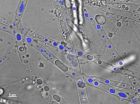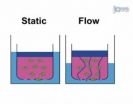(Press-News.org) This press release is available in German.
Leipzig. Fungi are found throughout the soil with giant braiding of fine threads. However, these networks have surprising functions. Only a few years ago researchers from the Helmholtz Centre for Environmental Research (UFZ) discovered that bacteria travel over the fungal threads through the labyrinth of soil pores, much the same as on a highway. Now, together with British colleagues from the University of Lancaster, the UFZ researchers have come upon another phenomenon. Accordingly, the fungal networks also transports contaminants which are otherwise largely immobile in the ground. These living pipelines can therefore contribute to the restoration of impacted areas, write the researchers in the journal Environmental Science & Technology.
Some bacteria develop a voracious appetite for contaminants. They nourish themselves from toxic chemicals and at the same time convert these to harmless substances. This makes them valuable allies for the elimination of different forms of environmental pollution. Certain soil microbes, for example, are fully capable of restoring impacted ground by natural means. Theoretically at least. In practice, however, the tiny helpers are frequently pushed to their limits. "The problem is that the contaminants often do not even reach them", explains UFZ researcher Lukas Y. Wick, in charge of the new study.
The bacteria frequently have difficulties with substances which are largely insoluble in water. These include, for example, the polycyclic aromatic hydrocarbons (PAHs) found in crude oil and coal, released in practically all combustion processes. Along well-travelled roads, in the vicinity of airports or old gas works sites, the ground can also be polluted with these compounds. As many PAHs are considered to be carcinogenic, the help of bacteria for the degradation of this pollution would be entirely welcome.
In the complicated labyrinth of water-filled and air-filled pores found throughout the soil, however, bacteria and PAHs rarely come together. This is because the microorganisms are predominantly found in water and in thin liquid films. "The PAHs are virtually insoluble in water, so that they frequently staple themselves to particles of ground in tiny, air-filled pores", which the bacteria are unable to reach, explains Lukas Y. Wick. Between them and their sources of nutrition there are air barriers.
A living network
Nevertheless, there are soil organisms which can effectively overcome such barriers. These include fungi and a group of similar organisms which biologists describe as "pseudo-fungi". Both can grow either in water or in air and are found throughout the soil with a network of fine threads. Each of these so-called hyphae is in fact only a few thousandths of a millimetre thick. Yet, together they form a network of enormous dimensions. One single gram of soil may contain up to 1000 to 10,000 meters of fungal threads. A single braid thereby can extend over several square kilometres. Fungi are therefore in fact the largest living creatures on the Earth today.
That bacteria are fully capable of utilising the infrastructure of this huge neighbour, emerges from an earlier study of Lukas Y. Wick and his colleagues. The fungal braiding appears to be a kind of highway over which the microorganisms can effectively travel and propagate. They move on the surface of the hyphae and, in this way, overcome the air barriers between two water-filled pores without problem.
But what if the fungal network offers good travel possibilities not only for bacteria, but for contaminants as well? Nevertheless, it is known that the transport of nutrients which the fungus requires to survive takes place within the hyphae. Why should this not function, then, with other substances? Together with colleagues from the University of Lancaster, the UFZ researchers have now pursued this question.
For their investigations the researchers employed a pseudo-fungus with the name Pythium ultimum, which is widespread in the soil. This was placed on a central plate with nutrients, proceeding from which it could extend its hyphae to the right and left to two further sources of nourishment. The three nourishment stations were connected by rectangles of nourishment-free material. However, there were several gaps between the nourishment plates and rectangles containing only air. These were intended to simulate the air-filled pores in the ground.
At the edge of a rectangle the UFZ researchers applied a polycyclic aromatic carbohydrate with the name Phenanthrene. They then investigated at regular intervals whether this substance could be detected in other areas of the test path. "The results were astounding", says Lukas Y. Wick. Within a few hours the carbohydrate had migrated from one end of the experimental arrangement to the other – from ten to one hundred times faster than it could have by simple diffusion. Furthermore, it overcame the air gaps with no difficulty, which was not possible over the same path without hyphal networks. "The hyphal networks are therefore not only highways for bacteria, but also pipelines for contaminants", concludes Lukas Wick. "Per hour a single hypha can transport up to 600 times the weight of an individual bacterium".
With a special microscope of the British colleagues it was even possible to observe this transport in detail. Accordingly, the contaminant migrates through the cell wall into the interior of the hyphae. There it is enclosed in tiny bubbles, which Pythium ultimum then actively pumps through its far-reaching network.
Contaminants in motion
In this way the fungal pipeline mobilises not only Phenanthrene, but also other substances virtually insoluble in water and therefore sooner immobile substances. The researchers repeated the experiment with a number of different PAHs, and all were found to be efficiently transported. However, over longer paths the transport of small molecules functioned better than that of large molecules. "Presumably the latter are not taken up as well by the hyphae", in the opinion of Lukas Y. Wick.
In this experiment even the longer paths consisted of only a few centimetres. This may appear to be relatively little, however it could still prove decisive for better contact between the contaminants and their decomposers, as the fungal pipeline effortlessly overcomes the minute air barriers between the water-filled soil pores.
The researchers hope that this effect can be utilised in future for the restoration of impacted ground. The targeted use of fungal networks could accelerate the degradation of PAHs and perhaps also of other substances virtually insoluble in water. "But this may function only when one combines the right fungi and bacteria", explains Lukas Y. Wick. Some types of these organisms are simply not compatible or even mutually inhibit each other. Consequently, the UFZ researchers are now searching for the most suitable partners for their microbial contaminant eliminator team.
Kerstin Viering
INFORMATION:
Publication:
Shoko Furuno, Susan Foss, Ed Wild, Kevin C. Jones, Kirk T. Semple, Hauke Harms and Lukas Y. Wick (2012): Mycelia Promote Active Transport and Spatial Dispersion of Polycyclic Aromatic Hydrocarbons. Environ. Sci. Technol. 2012, 46, 5463−5470 http://dx.doi.org/10.1021/es300810b
The studies were founded by the EU project MC-20 984 EST (RAISEBIO) and by the Helmholtz Association ("CITE - Chemicals in the Environment").
Further Information:
Helmholtz Centre for Environmental Research (UFZ)
Dr. Lukas Y. Wick
phone: +49-341-235-1316
http://www.ufz.de/index.php?de=13567
or via
Tilo Arnhold (UFZ Press Office)
Phone: +49-341-235-1635
www.ufz.de/index.php?en=640
Links:
Scientists demonstrate the existence of underground 'highways' for bacteria (Press release, 8. February 2007):
http://www.ufz.de/index.php?en=10837
At the Helmholtz Centre for Environmental Research (UFZ) scientists are researching the causes and consequences of far-reaching changes to the environment. They are concerned with water resources, biological diversity, the consequences of climate change and adaptability, environmental and biotechnologies, bioenergy, the behaviour of chemicals in the environment, their effect on health, modelling and social science issues. Their guiding theme: Our research contributes to the sustainable use of natural resources and helps to secure this basis for life over the long term under the effects of global change. The UFZ employs 1,000 people in Leipzig, Halle and Magdeburg. It is financed by the federal government and the federal states of Saxony and Saxony-Anhalt.
http://www.ufz.de/
The Helmholtz Association contributes towards solving major and pressing social, scientific and economic issues with scientific excellence in six research areas: Energy, Earth and Environment, Health, Key Technologies, Structure of Matter, Aeronautics, Aerospace and Transport. The Helmholtz Association is Germany's largest scientific organisation with over 33,000 employees in 18 research centres and an annual budget of approximately 3.4 billion euros. Its work stands in the tradition of the naturalist Hermann von Helmholtz (1821-1894).
http://www.helmholtz.de
Contaminant transport in the fungal pipeline
2012-07-26
ELSE PRESS RELEASES FROM THIS DATE:
Miriam researchers urge physicians to ask younger men about erectile dysfunction symptoms
2012-07-26
PROVIDENCE, R.I. – Although erectile dysfunction (ED) has been shown to be an early warning sign for heart disease, some physicians – and patients – still think of it as just as a natural part of "old age." But now an international team of researchers, led by physicians at The Miriam Hospital, say it's time to expand ED symptom screening to include younger and middle-aged men.
In an article appearing in the July issue of the American Heart Journal, they encourage physicians to inquire about ED symptoms in men over the age of 30 who have cardiovascular risk factors, such ...
In muscular dystrophy, what matters to patients and doctors can differ
2012-07-26
Complex, multi-system diseases like myotonic dystrophy – the most common adult form of muscular dystrophy – require physicians and patients to identify which symptoms impact quality of life and, consequently, what treatments should take priority. However, a new study out this month in the journal Neurology reveals that there is often a disconnect between the two groups over which symptoms are more important, a phenomenon that not only impacts care but also the direction of research into new therapies.
"In order to design better therapies we must first develop a clear ...
New gene therapy strategy boosts levels of deficient protein in Friedreich's ataxia
2012-07-26
New Rochelle, NY, July 25, 2012—A novel approach to gene therapy that instructs a person's own cells to produce more of a natural disease-fighting protein could offer a solution to treating many genetic disorders. The method was used to achieve a 2- to 3-fold increase in production of a protein deficient in patients with Friedreich's ataxia, as described in an article published Instant Online in Human Gene Therapy, a peer-reviewed journal from Mary Ann Liebert, Inc. (http://www.liebertpub.com) The article is available free online at the Human Gene Therapy website (http://www.liebertpub.com/hum).
The ...
ONR-funded research takes flight in Popular Science article
2012-07-26
ARLINGTON, Va.—The Office of Naval Research (ONR) is looking at birds' perceptual and maneuvering abilities as inspiration for small unmanned aerial vehicle (UAV) autonomy, and Popular Science is featuring this effort in its August issue, posted online July 25.
An ONR-funded, five-year Multidisciplinary University Research Initiative (MURI) program is examining the control and behavioral processes of birds and other small animals when flying at high speeds through complex environments, such as forests or urban settings. Researchers are trying to understand why birds make ...
Study links alcohol/energy drink mixes with casual, risky sex
2012-07-26
BUFFALO, N.Y. -- A new study from the University at Buffalo's Research Institute on Addictions (RIA) has found a link between the consumption of caffeinated energy drinks mixed with alcohol and casual -- often risky -- sex among college-age adults.
According to the study's findings, college students who consumed alcohol mixed with energy drinks (AmEDs) were more likely to report having a casual partner and/or being intoxicated during their most recent sexual encounter.
The results seem to indicate that AmEDs may play a role in the "hook-up culture" that exists on ...
Mind vs. body? Dualist beliefs linked with less concern for healthy behaviors
2012-07-26
Many people, whether they know it or not, are philosophical dualists. That is, they believe that the brain and the mind are two separate entities. Despite the fact dualist beliefs are found in virtually all human cultures, surprisingly little is known about the impact of these beliefs on how we think and behave in everyday life.
But a new research article forthcoming in Psychological Science, a journal of the Association for Psychological Science, suggests that espousing a dualist philosophy can have important real-life consequences.
Across five related studies, researchers ...
Public strongly supports programs helping farmers adapt to climate change
2012-07-26
EAST LANSING, Mich. — A survey conducted by Michigan State University reveals strong public support for government programs to assist farmers to adapt to climate change.
According to NASA research, global temperatures have been rising for decades, and it's affecting all aspects of agriculture. Regardless of what those surveyed believe causes climate change, more than 65 percent of them support government assistance for farmers, said Scott Loveridge, MSU professor of agricultural, food and resource economics.
This year has been a particularly harsh example. This summer's ...
NASA and university researchers find a clue to how life turned left
2012-07-26
GREENBELT, Md. -- Researchers analyzing meteorite fragments that fell on a frozen lake in Canada have developed an explanation for the origin of life's handedness – why living things only use molecules with specific orientations. The work also gave the strongest evidence to date that liquid water inside an asteroid leads to a strong preference of left-handed over right-handed forms of some common protein amino acids in meteorites. The result makes the search for extraterrestrial life more challenging.
"Our analysis of the amino acids in meteorite fragments from Tagish ...
Women with diabetes more likely to experience sexual dissatisfaction
2012-07-26
Women with diabetes are just as likely to be interested in, and engage in, sexual activity as non-diabetic women, but they are much more likely to report low overall sexual satisfaction, according to a UCSF study.
The researchers also found that diabetic women receiving insulin treatment were at higher risk for the specific complications of lubrication and orgasm.
"Diabetes is a recognized risk factor for erectile dysfunction in men, but there have been almost no data to indicate whether it also affects sexual function in women," said senior author Alison J. Huang, ...
How the fluid between cells affects tumors
2012-07-26
July 25, 2012
There are many factors that affect tumor invasion, the process where a tumor grows beyond the tissue where it first developed. While factors like genetics, tissue type and environmental exposure affect tumor metastasis and invasion, physical forces like fluid flow remain a poorly understood component of tumor invasion. A new video article in JoVE, the Journal of Visualized Experiments, describes a novel procedure that allows researchers to study and test the microenvironment of a growing tumor. The technique is valuable because it allows scientists to assay ...




